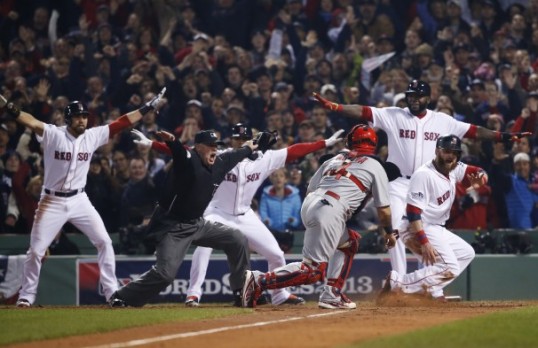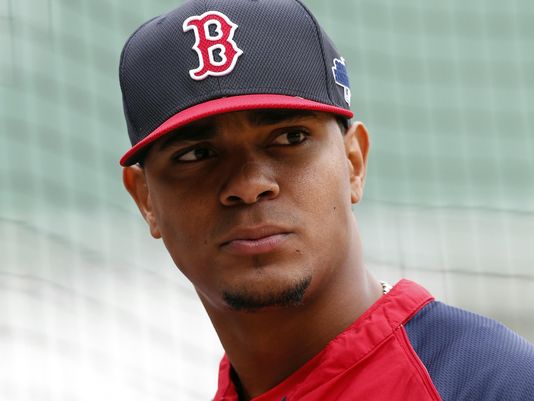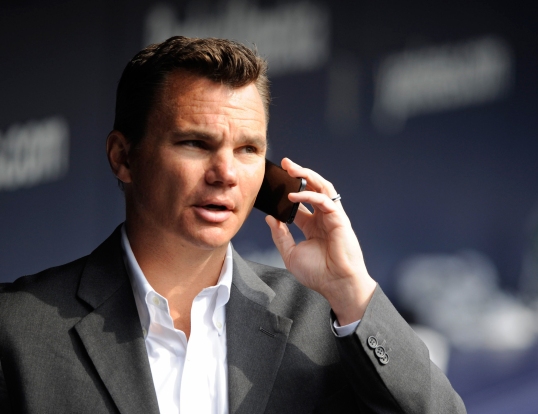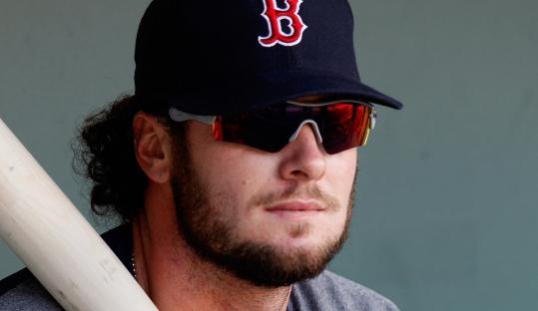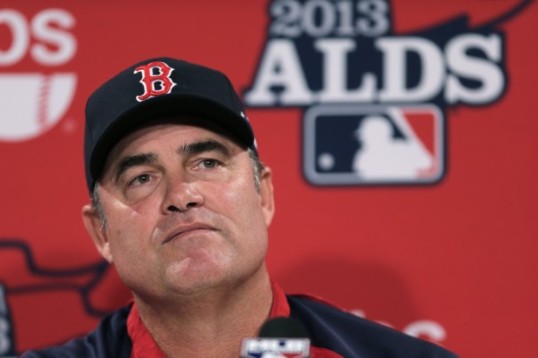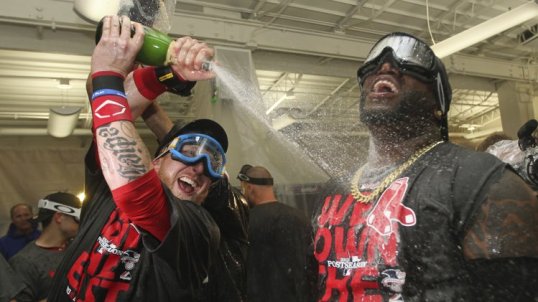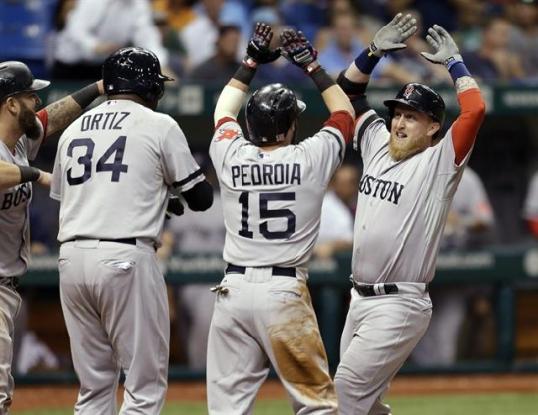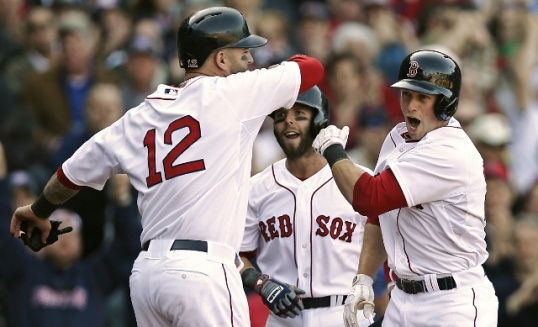
The Red Sox won a game in early April on a cool, cloudy day against a division rival by a score of 3-1. It was one simple game plucked out of the first week of what is a long six-month regular season. There were no extra innings. There were no walk-offs.
Sitting in the right field bleachers on April 8, Opening Day at Fenway Park, I had no idea that the performance I was witnessing would, in many ways, come to epitomize the eventual 2013 World Series Champion Boston Red Sox.
I believe that the members of this year’s Red Sox team genuinely enjoyed each other’s company. Furthermore, I’m confident that the guys in that clubhouse truly cared about one another–a trait that Terry Francona often highlighted as being vital to any team’s success. There is no doubt that the 2013 Red Sox possessed a unique blend of character, camaraderie, and yes, chemistry. Sometimes, however, teams that are labeled as possessing good chemistry often have their talents overlooked. Teams bereft of talent that bulge with chemistry don’t win 97 games, and they certainly don’t win championships.
When an average pitcher does not have his stuff on a given day, there is a good chance that major league hitters will make him pay. Conversely, when a pitcher who is supremely talented, like Clay Buchholz, lacks his usual sharpness, there is still an opportunity to be successful. April 8 was one of those days for the slender righty. Against a relatively tough Orioles lineup that featured excellent hitters like Manny Machado, Chris Davis, and Adam Jones, Buchholz tossed seven frames, punched out eight batters, and earned his second win in as many starts. By all accounts, he was masterful on that spring afternoon in Boston. Here is what Buchholz said after that game: “I didn’t really have one thing that was working the whole day. [I] Was up in the zone, couple of balls hit early that would’ve gotten out stayed in the park. Other than that it was sorta a grind there for a little bit.” Must be nice, right?
Players — the actual guys who put on the uniform — routinely tell us about the importance of chemistry, so who are we to dismiss it simply because we can’t quantify it? Nevertheless, talent, for me, always wins out. Give me talent before anything else. And this Red Sox team provided us with plenty of it.
In 2011, the Red Sox possessed a talent-laden roster. On paper, they looked like an absolute wagon. Theo Epstein and Co. added Carl Crawford and Adrian Gonzalez to a core group of quality players that was already in place here. For much of the season, things seemed to click. The vast majority of the 2011 campaign was actually wildly successful, but no one will ever remember the good days of that summer (on August 9, the Red Sox were 29 games over .500). Instead, fans will recall a dreadful September in which the team went 7-20, relinquishing a nine-game lead for the only Wild Card spot, and, of course, chicken and beer. All of those things may be true, but the focus shouldn’t be on Bud Light and Popeyes. The proverbial finger should be pointed directly at that team’s lack of depth. Kyle Weiland started five extremely meaningful games (three came in September) for the Red Sox in 2011. The righty was, as you might expect, absolutely awful (7.66 ERA in seven appearances). He last pitched in a major league game in April of 2012. The fact that Weiland played a legitimate role in the Red Sox season and subsequent collapse is rather embarrassing. Ben Cherington, who was the assistant GM of the Red Sox in 2011, had a keen understanding of the importance of depth when he assembled this year’s squad.
On April 8, when Buchholz was finished baffling Orioles batters, he turned things over to Andrew Bailey who looked excellent in his first two appearances of the season. Bailey kept rolling, punching out two of the three batters he faced. Joel Hanrahan pitched the ninth inning of that game, allowing one run. It was clear that the Red Sox had identified their setup man and closer. Of course, no one knew that the pair of hard throwing right handers wouldn’t throw another pitch after July 12.
When a team loses its all-star closer to a season-ending injury, they’re usually not able to replace him with another former all-star who is a proven back end of the bullpen piece. But that’s exactly what the Red Sox did when Hanrahan went down with a torn flexor tendon, and they were able to turn to Bailey. Ultimately and somewhat unsurprisingly, Bailey was lost for the season and required surgery to repair his shoulder. John Farrell turned briefly to Junichi Tazawa before handing the keys to the car over to Koji Uehara on June 26. Uehara never gave them back as he accumulated 21 regular season saves and seven in the postseason. He made sure to collect hundreds of high fives along the way.
There is no doubt that Cherington knew what he was doing when he added Hanrahan and Uehara to a bullpen that already had two guys who possessed arsenals that lend themselves to the closer role. Bailey was a proven closer, and Tazawa is an excellent pitcher who rarely walks a batter and has the ability to throw in the mid-90’s. Heading into the season, a case could be made that there was some redundancy in the Red Sox bullpen, but, because of that depth, they were able to overcome attrition and turn what easily could have evolved into a weakness into a legitimate strength.
Depth is something that general managers can build. To a certain extent, they can control it. Could Cherington have splurged, gone out and signed a sexy free agent, like Josh Hamilton? You bet. But it would have limited his ability to infuse talent around the diamond and build depth in certain areas. David Ross, Jonny Gomes, and Uehara are three good examples of players who Cherington could have simply passed on without getting a ton of pushback from the fanbase. Timeliness, on the other hand, is a characteristic that general managers do not have much control over, but most good teams seem to find a way to come up large in big spots.
Wei-Yin Chen was matching Buchholz blow for blow, frame after frame. The Red Sox offense was essentially lifeless. Chen was dealing. Then Dustin Pedroia led off the bottom of the seventh inning with an infield single. Mike Napoli then jolted a ball to center for a double. Will Middlebrooks followed with a strikeout for the first out of the inning. Daniel Nava stepped in, batting from the right side. He took a ball and fouled off the next pitch. Chen’s third offering was clobbered by Nava. When the ball landed beyond the big green wall in left, it was 3-0 Red Sox. A game and an afternoon that had been a pitcher’s duel in every way suddenly and indelibly changed because of one well-timed swing.
Nava, the man who delivered the deciding blow that day, is a player who likely wouldn’t have been in the lineup that afternoon if David Ortiz had been completely healthy at the beginning of the year. Ortiz would have been the designated hitter. Gomes would have moved out of the DH role and slid into left field against the southpaw. But because of the Red Sox outfield depth, Farrell had the ability to use the versatile Nava in left that day. An undrafted former independent league standout, Nava’s talents are often overlooked because of his remarkable story. In reality, Nava is a very good ballplayer. He finished eighth in the American league with a .303 average, and his .385 OBP was good for fifth among AL hitters. And on this day in early April, Nava was incredibly timely.
The 2013 Red Sox are going to be remembered as an unlikely champion, a group of guys who loved baseball and beards. But for those of us who watched this team everyday, we’ll recall them as a talented, deep collection of players who had a knack for getting the timely hit. Time after time after time after time.
Posted in
Red Sox Evaluations 2013 and tagged
2013 Red Sox,
Adam Jones,
Adrian Gonzalez,
Andrew Bailey,
Carl Crawford,
Chris Davis,
Clay Buchholz,
Daniel Nava,
David Ortiz,
David Ross,
Dustin Pedroia,
Joel Hanrahan,
John Farrell,
Jonny Gomes,
Josh Hamilton,
Junichi Tazawa,
Koji Uehara,
Kyle Weiland,
Manny Machado,
Mike Napoli,
Terry Francona,
Wei-Yin Chen,
Will Middlebrooks,
World Series

